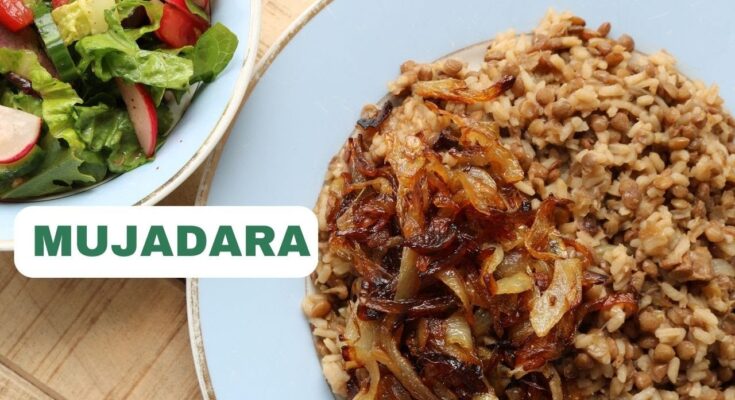Mujadara Recipe: Mujadara is a humble yet deeply flavorful Middle Eastern dish made from a simple combination of lentils, rice, and caramelized onions. Despite its minimal ingredients, this dish delivers a rich taste and comforting texture that has won hearts across many cultures. It’s especially popular in Lebanon, Syria, Palestine, and Jordan, where it is often regarded as a staple meal. The dish is perfect for anyone seeking a nutritious, budget-friendly, and plant-based recipe that doesn’t skimp on flavor.
What makes Mujadara stand out is the golden-brown onions that are cooked slowly to develop a sweet, deep caramelization, then mixed with tender lentils and fluffy rice. This marriage of ingredients results in a warm, savory, and slightly sweet flavor profile. Its appeal lies in its simplicity—basic pantry staples come together to create something incredibly delicious and filling. Whether you’re cooking for your family or preparing meals for the week, Mujadara is a reliable and rewarding option.
The Cultural and Historical Significance
Mujadara isn’t just food; it’s history served on a plate. It’s been enjoyed for centuries and appears in some of the earliest Arabic cookbooks dating back to the 13th century. Often referred to as “poor man’s food,” Mujadara was traditionally eaten by the working class due to its affordability and nutritional richness. But don’t let that humble title fool you—its complex flavors have elevated it to a cherished delicacy, often served during Lent, Ramadan, or other fasting periods because it’s meat-free yet deeply satisfying.
Across generations, families have passed down their unique takes on Mujadara. Some use brown rice; others prefer bulgur. Some add spices like cumin or cinnamon, while others keep it classic. It’s a dish that reflects the personality and palate of the home it’s made in. And in modern kitchens, it continues to bridge the gap between the old world and the new, offering a taste of tradition with every bite.
Ingredients Needed for Mujadara
Core Ingredients
Before diving into the cooking process, let’s take a look at the essential ingredients needed for Mujadara. Each of these components plays a vital role in achieving the perfect balance of flavor and texture:
- Brown or green lentils (1 cup): These hold their shape well when cooked and offer a nutty, earthy flavor.
- Long grain rice or basmati rice (1 cup): Adds body and absorbs the aromatic flavors of the onions and spices.
- Onions (3 large): Thinly sliced for caramelizing. The onions are key to the depth of flavor in this dish.
- Olive oil (1/3 cup): Used generously for frying the onions and cooking the rice and lentils.
- Salt (to taste): Essential for bringing all the flavors together.
- Black pepper (1 tsp): Adds subtle heat and enhances the dish’s natural flavors.
Optional Additions for Enhanced Flavor
To elevate your Mujadara and tailor it to your taste, you can include some optional ingredients. These are not traditional, but they’re often used in modern kitchens:
- Ground cumin (1 tsp): Adds warmth and a hint of smokiness.
- Ground coriander (1/2 tsp): Provides a citrusy undertone.
- Bay leaf (1): Adds aromatic depth during cooking.
- Cinnamon stick (optional): For a subtle sweet spice element.
- Lemon juice (1 tbsp): Squeezed on top before serving for brightness.
- Fresh parsley (for garnish): Adds a pop of color and freshness.
These optional ingredients can help you customize your Mujadara to suit your flavor preferences. Want a more earthy and spiced version? Add cumin and coriander. Prefer it bright and tangy? Go with lemon juice and parsley.
Preparing Mujadara Step by Step
Step 1 – Rinsing and Soaking the Lentils
Begin by placing the lentils in a colander and rinsing them under cold water. This helps remove any dust or debris. You can then soak them for about 15-20 minutes if you want to reduce cooking time and enhance digestibility. Soaking isn’t mandatory, but it’s a helpful step for those sensitive to legumes.
Once rinsed and soaked, drain the lentils and set them aside. This step ensures the lentils cook evenly and absorb flavors more effectively later in the process.
Step 2 – Cooking the Lentils
Place the lentils in a medium pot, add 2 ½ cups of water, and bring to a boil. Once boiling, reduce the heat and let them simmer for about 15-20 minutes until they’re just tender but not mushy. The lentils should hold their shape as they’ll continue to cook with the rice later.
During this time, you can season the lentils with a bay leaf or a pinch of salt for added depth. Once done, drain any excess water and set the cooked lentils aside.
Step 3 – Caramelizing the Onions
This is arguably the most important step in making Mujadara. In a large skillet, heat the olive oil over medium heat. Add the thinly sliced onions and sauté, stirring often. You’ll want to cook them for at least 25-30 minutes until they’re deep golden brown and almost crispy. Patience is key here—don’t rush it!
The caramelized onions are the heart of the dish. They provide sweetness, texture, and a rich umami flavor that infuses the rice and lentils. Once they’re done, remove a few tablespoons to use as a garnish later and keep the rest in the pan.
Step 4 – Cooking the Rice
Now that your onions are beautifully caramelized, it’s time to cook the rice. Add the uncooked, rinsed rice directly into the skillet with the remaining caramelized onions and their oil. Stir the rice for a few minutes to coat each grain with the onion-infused oil. This step adds a deeper layer of flavor and helps prevent the rice from becoming sticky.
Next, pour in 2 cups of water and bring the mixture to a boil. Once it’s boiling, reduce the heat to low, cover the skillet, and allow it to simmer for about 10-12 minutes. Keep an eye on the rice—when most of the water is absorbed and the grains are just tender, it’s ready for the next step. Cooking the rice with the onions is what gives Mujadara its signature taste, where every bite bursts with sweet and savory richness.
Step 5 – Combining and Simmering
Time to bring it all together! Add the cooked lentils to the pot of rice and onions. Gently fold the mixture together, ensuring the lentils are evenly distributed. If needed, add a splash more water—just enough to keep the mixture moist while it finishes cooking. Cover the pot again and let it simmer on very low heat for another 10 minutes.
This step allows the flavors to meld together, giving the Mujadara a cohesive and well-rounded taste. As it simmers, the lentils and rice absorb more of the onion flavor, and everything reaches that perfect soft-yet-firm consistency. Turn off the heat and let it sit, covered, for an additional 5 minutes before fluffing it up with a fork.
Now, top your dish with the reserved caramelized onions, and you’re ready to serve a comforting, aromatic bowl of Mujadara that’s guaranteed to satisfy.
Serving Suggestions
Best Accompaniments for Mujadara
Mujadara is a complete meal on its own, but it shines even brighter when paired with the right sides. Its earthy and hearty nature pairs beautifully with light, fresh additions:
- Simple green salad: Lettuce, cucumber, and tomatoes with a lemon-olive oil dressing work wonderfully.
- Plain yogurt or tzatziki: These creamy elements provide a cool contrast to the warmth of the dish.
- Pickled vegetables: The acidity and crunch offer a delightful counterpoint to the soft textures of Mujadara.
- Fresh herbs: A sprinkle of parsley, cilantro, or mint adds freshness and color.
These accompaniments help balance the dish and make it feel more like a feast, especially when serving guests or making a family meal.
Presentation Tips
While Mujadara may not be the most visually striking dish on its own, you can easily elevate its presentation with a few tricks:
- Use a ring mold to shape it into a neat dome on the plate.
- Top with a generous spoonful of golden onions.
- Add a sprig of fresh parsley or mint for a pop of green.
- Serve it on a large platter surrounded by colorful side dishes for a Middle Eastern mezze-style spread.
Presentation makes a big difference when serving this dish to others—it turns humble ingredients into a gourmet-looking plate.
Health Benefits of Mujadara
Nutritional Value
One of the best things about Mujadara is how nutrient-dense it is. It’s loaded with plant-based protein from the lentils, providing energy and keeping you full longer. The rice delivers complex carbohydrates, while the onions bring antioxidants and anti-inflammatory properties.
Here’s a quick look at its health benefits:
- High in fiber: Great for digestion and maintaining blood sugar levels.
- Rich in iron and folate: Especially beneficial for vegetarians and those prone to anemia.
- Low in fat: Uses olive oil instead of butter or ghee, making it heart-healthy.
- Gluten-free: Perfect for those with gluten intolerance when using plain rice.
Mujadara is proof that comfort food can also be healthy. It’s a smart choice whether you’re watching your weight, building muscle, or simply trying to eat cleaner.
Ideal for Vegetarian and Vegan Diets
Because it’s entirely plant-based, Mujadara is a go-to option for vegetarians and vegans alike. There’s no dairy, meat, or eggs involved unless you choose to serve it with yogurt or non-vegan sides. Even better, it’s a complete protein meal when combined with rice—just like beans and rice, lentils and rice together provide all the essential amino acids.
It’s also great for meal prep. Make a big batch at the start of the week and you’ve got a nutritious, easy-to-reheat lunch or dinner option on hand. It holds up well in the fridge for up to 4 days and only gets more flavorful with time.
FAQs about Mujadara Recipe
Can Mujadara be frozen?
Yes! Mujadara freezes well for up to 3 months. Store it in airtight containers and reheat with a splash of water to refresh its texture.
Which type of rice is best?
Long-grain rice or basmati rice works best for Mujadara as they remain fluffy and separate after cooking, preventing a mushy texture.
Is Mujadara gluten-free?
Absolutely. As long as you use plain rice and don’t add any gluten-containing ingredients, Mujadara is naturally gluten-free.
How to make it spicier?
For a spicy kick, add a pinch of cayenne pepper or red chili flakes while cooking the rice. You can also serve it with a spicy salsa or harissa on the side.
Can I use canned lentils?
Yes, but make sure to rinse and drain them well. Also, reduce the cooking time since canned lentils are already cooked.
Conclusion
Mujadara is the perfect combination of simple ingredients, bold flavors, and satisfying textures. Whether you’re diving into Middle Eastern cuisine for the first time or revisiting a nostalgic favorite, this dish will not disappoint. It’s budget-friendly, easy to prepare, and incredibly versatile. From busy weeknights to leisurely weekend dinners, Mujadara deserves a permanent place in your recipe rotation.
So, gather your lentils, onions, and rice, and try making Mujadara from scratch. You’ll find yourself returning to this comforting, healthy dish again and again.



